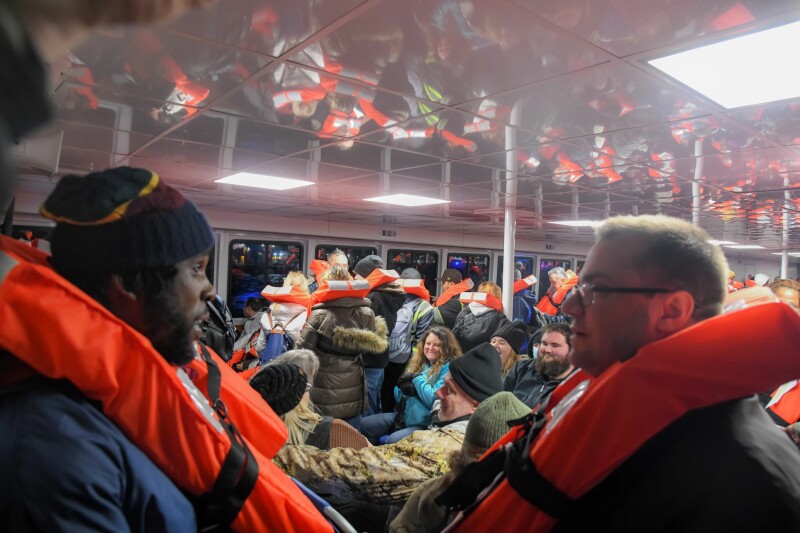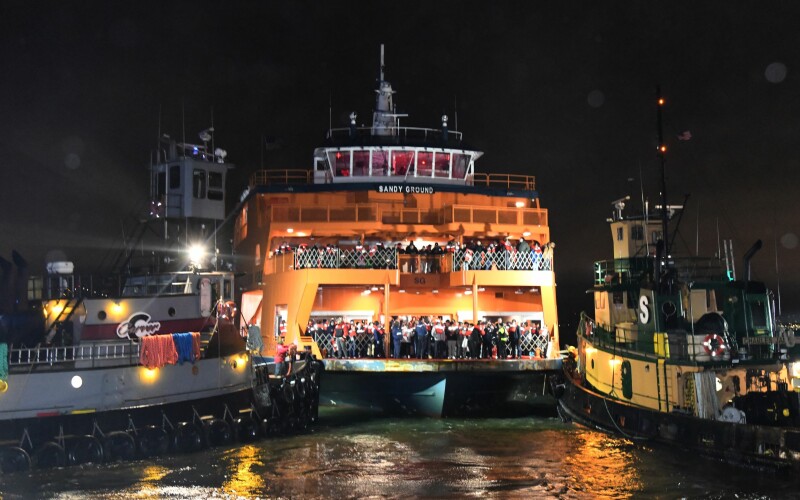When an engine room fire broke out on the Staten Island Ferry Sandy Ground shortly before 5 p.m. on Dec. 22, a cold, rainy afternoon, it could have been a disaster. Instead, it was a textbook example of how mariners, working together, kept everyone and everything safe.
The 330'x70' Sandy Ground, the newest Staten Island Ferry built at Eastern Shipbuilding Group in Florida, went into service in June 2022. It was on a routine 5 ½-mile passage from the Whitehall terminal in Lower Manhattan to St. George, Staten Island, with 868 passengers aboard. Partway through the trip, the crew saw fire in the engine room.
They immediately evacuated, closed off the space, and released 3M Novec 1230 fire protection fluid, a clean agent fire extinguishant, which effectively put the fire out, said Capt. Barry Torrey, assistant commissioner for ferry operations for the New York City Department of Transportation (NYCDOT). Torrey worked with Sandy Ground Capt. Joseph Ajar, and the 15-member crew by cell phone during the incident.
The fire, he said, was caused by a fuel leak that turned into a machinery space fire. There were no flames and minimal smoke throughout the vessel. The ferry had no propulsion so both anchors were dropped in a channel near Bayonne, N.J., as Ajar radioed for assistance. Police, fire, and Coast Guard vessels arrived along with five tugboats and several small passenger ferries. Another Staten Island Ferry stood by.

SAFE EVACUATION
Evacuating the passengers safely was the main priority. Many were frightened at first because they did not know what was going on. One said she feared the boat would blow up. The passengers calmed down as the crew kept them informed, helped them move to the ends of the vessel away from the midships fire zone, and assisted with life preservers.
Officials decided the safest way to offload people was to use smaller ferries from NYC Ferry (operated by Hornblower) and NY Waterway in bow-to bow-transfers. The 80'x27', 2,600-hp tug Mister Jim from Carver Marine Towing, and the 77'x26', 2,400-hp Charles James from Stasinos Marine LLC, tied up on either side of Sandy Ground, creating a virtual slip that buffered the smaller ferries from wind and waves.
The 85' NYC Ferry, River Sprinter, under the command of Capt. Paul Radzewsky, put its bow against the Sandy Ground and tied off. Crew from the Sandy Ground, River Sprinter, and the tugs helped 138 passengers aboard. River Sprinter dropped them at St. George and relayed land-based firefighters to the Sandy Ground.
NY Waterway’s Franklin Delano Roosevelt, with Capt. Tom Beckedorff at the helm, was standing by and snugged up to the Sandy Ground as soon as there was space. Crews from the ferries and tugs tied things off and guided passengers, almost all wearing lifejackets, aboard the Roosevelt. The decks were at the same height, so passengers could walk from one vessel to the other, rather than step down or jump. The Roosevelt, at 110'x32.5', is one of NY Waterway’s largest ferries, with a capacity 500 passengers. In this case, it took 568 evacuees. A video showed that the atmosphere on the boat was calm, even jovial, as a crewmember picked up a mike and started singing. Some passengers joined in.
There were still 50 or so people waiting to leave the Sandy Ground as the Roosevelt pulled away. “We’ll be back,” a crewmember said. But with the pressure of the tugs and the wind picking up, Sandy Ground’s anchors started to drag, so they decided, Torrey said, to end the transfers and keep the remaining passengers aboard as they raised anchor and tugs guided the big ferry into a slip at the St. George ferry terminal.
“We can’t undo the fire,” Torrey said, “but we can be pleased with how crews worked together. Together we evacuated 868 people safely, with just five minor injuries.”
PREPARATION AND TRAINING
The success was the result of constant training with weekly safety drills on the smaller ferries and regular coordination with police, fire, and Coast Guard. “This is New York Harbor,” Torrey said. “These guys talk to each other regularly on the radio. It’s not the first time in New York Harbor that professional mariners have come together to respond to a rescue without having done that exact event.” He referenced the 9/11 boatlift and the Miracle on the Hudson rescue of passengers from US Airways flight 1549 in 2009.
“This was not a lucky event,” Deputy Assistant FDNY Chief Frank Loeb said in a briefing after the evacuation. “This is years and a long time of preparation and training. The crew acted as the crew was supposed to act.”
The Coast Guard and NTSB are investigating the Sandy Ground fire. Hearings took place in late February. As of press time, the results had not been published. The vessel is awaiting repairs at Caddell Dry Dock and Repair Co. Inc. on Staten Island.
The Sandy Ground is the second of three $85 million Ollis-class ferries built for New York City by Eastern Shipbuilding. The first, the SSG Michael H. Ollis, went into service in February 2022. It was WorkBoat’s 2022 Boat of the Year.
The Sandy Ground had been operating without incident until the fire. The third Ollis-class ferry, the Dorothy Day, is on-site in New York Harbor, but the Department of Transportation has not yet taken delivery.
Immediately following the fire Staten Island Borough President Vito Fossella and members of a ferry workers union suggested that the Ollis-class ferries be taken out of service until a full investigation could be done. After consultation with the Coast Guard, NYC Fire Commissioner Laura Kavanagh said, there’s “no concern at all” about there being a problem on ferries with a similar design.
The Coast Guard was scheduled to host a ceremony on March 9 honoring the crews and vessels that assisted in the Staten Island Ferry evacuation, including the NYPD Marine Unit, FDNY Marine Unit, Coast Guard Station New York, and the tugboats Charles James, Eastern Dawn, Mister Jim, Paula Atwell, and Robert Burton, along with ferries Franklin Delano Roosevelt and River Sprinter.





